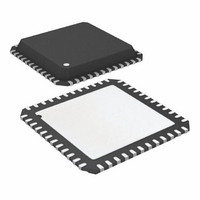ATA6613P-PLQW Atmel, ATA6613P-PLQW Datasheet - Page 204

ATA6613P-PLQW
Manufacturer Part Number
ATA6613P-PLQW
Description
MCU W/LIN TXRX REG WTCHDG 48-QFN
Manufacturer
Atmel
Series
AVR® ATA66 LIN-SBCr
Datasheet
1.ATA6612-EK.pdf
(364 pages)
Specifications of ATA6613P-PLQW
Core Processor
AVR
Core Size
8-Bit
Speed
16MHz
Connectivity
I²C, LIN, SPI, UART/USART
Peripherals
Brown-out Detect/Reset, POR, PWM, WDT
Number Of I /o
23
Program Memory Size
16KB (16K x 8)
Program Memory Type
FLASH
Eeprom Size
512 x 8
Ram Size
1K x 8
Voltage - Supply (vcc/vdd)
2.7 V ~ 5.5 V
Data Converters
A/D 8x10b
Oscillator Type
Internal
Operating Temperature
-40°C ~ 125°C
Package / Case
48-QFN Exposed Pad
Processor Series
ATA6x
Core
AVR8
Data Bus Width
8 bit
Data Ram Size
1 KB
Interface Type
I2C, SPI, USART
Maximum Clock Frequency
16 MHz
Number Of Programmable I/os
23
Number Of Timers
3
Maximum Operating Temperature
+ 125 C
Mounting Style
SMD/SMT
Minimum Operating Temperature
- 40 C
On-chip Adc
10 bit, 8 Channel
Lead Free Status / RoHS Status
Lead free / RoHS Compliant
Available stocks
Company
Part Number
Manufacturer
Quantity
Price
Company:
Part Number:
ATA6613P-PLQW
Manufacturer:
ATMEL
Quantity:
5 000
Part Number:
ATA6613P-PLQW
Manufacturer:
ATMEL/爱特梅尔
Quantity:
20 000
- Current page: 204 of 364
- Download datasheet (7Mb)
6.17.6.1
6.17.6.2
204
Atmel ATA6612/ATA6613
Receiving Frames with 5 to 8 Data Bits
Receiving Frames with 9 Data Bits
The Receiver starts data reception when it detects a valid start bit. Each bit that follows the
start bit will be sampled at the baud rate or XCKn clock, and shifted into the Receive Shift Reg-
ister until the first stop bit of a frame is received. A second stop bit will be ignored by the
Receiver. When the first stop bit is received, i.e., a complete serial frame is present in the
Receive Shift Register, the contents of the Shift Register will be moved into the receive buffer.
The receive buffer can then be read by reading the UDRn I/O location.
The following code example shows a simple USART receive function based on polling of the
Receive Complete (RXCn) Flag. When using frames with less than eight bits the most signifi-
cant bits of the data read from the UDRn will be masked to zero. The USART has to be
initialized before the function can be used.
Note:
The function simply waits for data to be present in the receive buffer by checking the RXCn
Flag, before reading the buffer and returning the value.
If 9-bit characters are used (UCSZn=7) the ninth bit must be read from the RXB8n bit in
UCSRnB before reading the low bits from the UDRn. This rule applies to the FEn, DORn and
UPEn Status Flags as well. Read status from UCSRnA, then data from UDRn. Reading the
UDRn I/O location will change the state of the receive buffer FIFO and consequently the
TXB8n, FEn, DORn and UPEn bits, which all are stored in the FIFO, will change.
Assembly Code Example
C Code Example
USART_Receive:
unsigned char USART_Receive( void )
{
}
; Wait for data to be received
sbis UCSRnA, RXCn
rjmp USART_Receive
; Get and return received data from buffer
in
ret
/* Wait for data to be received */
while ( !(UCSRnA & (1<<RXCn)) )
/* Get and return received data from buffer */
return UDRn;
1. The example code assumes that the part specific header file is included.
For I/O Registers located in extended I/O map, “IN”, “OUT”, “SBIS”, “SBIC”, “CBI”, and “SBI”
instructions must be replaced with instructions that allow access to extended I/O. Typically
“LDS” and “STS” combined with “SBRS”, “SBRC”, “SBR”, and “CBR”.
r16, UDRn
;
(1)
(1)
9111H–AUTO–01/11
Related parts for ATA6613P-PLQW
Image
Part Number
Description
Manufacturer
Datasheet
Request
R

Part Number:
Description:
MCU W/LIN TXRX REG WTCHDG 48-QFN
Manufacturer:
Atmel
Datasheet:

Part Number:
Description:
Ata6613
Manufacturer:
ATMEL Corporation
Datasheet:

Part Number:
Description:
BOARD DEMO LIN-MCM FOR ATA6613
Manufacturer:
Atmel
Datasheet:

Part Number:
Description:
DEV KIT FOR AVR/AVR32
Manufacturer:
Atmel
Datasheet:

Part Number:
Description:
INTERVAL AND WIPE/WASH WIPER CONTROL IC WITH DELAY
Manufacturer:
ATMEL Corporation
Datasheet:

Part Number:
Description:
Low-Voltage Voice-Switched IC for Hands-Free Operation
Manufacturer:
ATMEL Corporation
Datasheet:

Part Number:
Description:
MONOLITHIC INTEGRATED FEATUREPHONE CIRCUIT
Manufacturer:
ATMEL Corporation
Datasheet:

Part Number:
Description:
AM-FM Receiver IC U4255BM-M
Manufacturer:
ATMEL Corporation
Datasheet:

Part Number:
Description:
Monolithic Integrated Feature Phone Circuit
Manufacturer:
ATMEL Corporation
Datasheet:

Part Number:
Description:
Multistandard Video-IF and Quasi Parallel Sound Processing
Manufacturer:
ATMEL Corporation
Datasheet:

Part Number:
Description:
High-performance EE PLD
Manufacturer:
ATMEL Corporation
Datasheet:

Part Number:
Description:
8-bit Flash Microcontroller
Manufacturer:
ATMEL Corporation
Datasheet:











